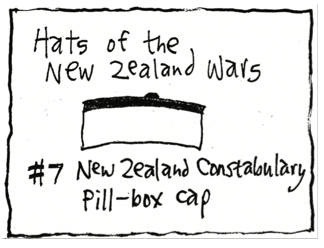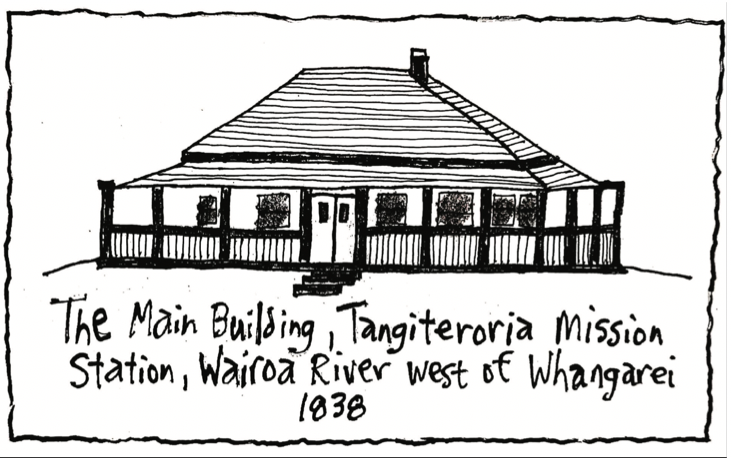By 1842, 3,000 Maori had converted to Christianity. Or had they? The Maori are a complicated people. They take what they like from the new religions and convert it to their own use. Some begin to believe that they are one of the “Lost Tribes of Israel”. Others use their Bibles and prayer books as cartridge papers for gunpowder. They think it is great fun that the Anglican, Catholic and Wesleyan missionaries don’t like each other in the same way that they don’t like other tribes. There are now Protestant and Catholic Maori.
The Catholics had the first bishop in New Zealand, who much impressed the Maori with his “long purple cassock, sash, episcopal ring, and great tasseled hat” (1841). The Protestants then send a bishop to New Zealand to try to win converts to their side by also wearing an impressive uniform (1842).
But in their efforts to prevent war between the Maori, the missionaries are often caught in the middle. The Rotorua Maori kill a Tauranga Maori chief and give the head to a missionary. An honour. Refuse it and you have an enemy. Accept it and you have an enemy. The Tauranga Maori swear to burn down the missionary’s house.
The Tauranga Maori then attack the Rotorua Maori at Maketu, telling the missionaries there: “If you are angry with me I will kill and eat all the missionaries” (1836). The Rotorua Maori withdraw to Rotorua. The Tauranga Maori attack Rotorua, ambush and kill many Rotorua Maori, loot the mission station, and leave behind “a valley of bones of men hideous to look upon”.
The Thames Maori attack the Tauranga Maori and cannot understand the missionaries’ concern for them: “Have they not eaten my mother?” The Tauranga Maori then want to kill the Thames Maori chief and eat him too (“pork is the food for the Pakeha, flesh for the Maori” 1842).
As well as the missionaries, the British government is also caught in New Zealand. On the one hand, they don’t want the problems of another colony. At this time Western Australia (1829) and South Australia (1836) are not doing well. On the other hand, there are British subjects in New Zealand calling for protection from the Maori, and for protection of the Maori from each other.
Missionaries, churches, the New South Wales governor, settlers, Maori chiefs and Samuel Marsden are demanding action by the British government. Marsden writes: “Some civilised government must take New Zealand under its protection, or the most dreadful evils will be committed by runaway convicts, sailors and publicans” (1837). Britain is being pulled reluctantly into New Zealand. And then there’s the French.
There’s always the French. Throughout British history, the French are always there or thereabouts. Somewhere. Doing something irritating to annoy the British (France is historically Britain’s number one enemy). Baron Philip (or Phillipe) Hippolytus (or Hippolyte) de Thierry (or De Thierry), is a colourful Frenchman with a confusing name and a complicated existence. He meets Thomas Kendall and the two Maori chiefs at Cambridge University, and through Kendall buys (he thinks) land for a colony at Hokianga Harbour, New Zealand.
He applies to the British government to become a colony, but is refused (“New Zealand was not a possession of the Crown” 1823). He proposes that the Dutch government take over New Zealand, but this fails. He applies to the French government to become a colony, but is refused. So he goes to New Zealand himself with 93 (or 68) colonists picked up in Australia, and the last of his money, and calls himself “Sovereign Chief of New Zealand” (1837).
The Maori think he is great fun and call him “King Unauthorised”. The British settlers “sneer” at him. The missionaries don’t know what to do with him. His followers leave. He hoists his family flag and lives in the upper harbour on land given to him, goes to the California gold rush, returns to Auckland, becomes a music teacher, and dies in 1864. An eccentric Frenchman, but harmless. And certainly not a dangerous military threat. There are still de Thierrys (or De Thierrys) in New Zealand today.
In 1838 a French whaling captain buys (he thinks) the Banks Peninsula from the Maori. He hurries home to France, forms a colonising company, gets the backing of the French government, and returns to New Zealand with 63 colonists, dozens of croissants (slightly stale), and a French warship (1840).
Unfortunately for them they call in at The Bay of Islands first. The Governor hears of their plans and sends a ship, some magistrates and a British flag to Akaroa before the French can get there. When the French arrive they find the British flag flying and a court in session just like they’d been there for some time, when actually they’d only just arrived five days before the French. The trick works.
The French colonists are not there to fight, and they muck right in with the British and Maori, planting white grapes, Normandy poplars, Bourbon hedges and willows from Napolean’s grave on St. Helena; before eventually “selling” their interest to the New Zealand Company in 1849. The Catholic missionaries later close their mission station in Akaroa and leave because “these French aren’t Catholic enough”.

- Chapter One Part one: A Humorous History of NZ
- Chapter One Part two: A Humorous History of NZ
- Chapter Two Part one: NZ is Formed
- Chapter Two Part two: NZ is Formed
- Chapter Three Part One: People Come to NZ
- Chapter Three Part Two: People Come to NZ
- Chapter Four Part One: The Maori of New Zealand
- Chapter Four Part Two: The Maori of New Zealand
- The Dutch in NZ: Chapter Five Part One
- The Dutch in NZ: Chapter Five Part Two
- The British & the French in New Zealand: Chapter Five Part Three
- The British & the French in New Zealand: Chapter Five Part Four
- The British Come to New Zealand For Good: Chapter Six Part One
- The British Come to New Zealand For Good: Chapter Six Part Two
- The British Come to New Zealand For Good: Chapter Six Part Three
- The British Come to New Zealand For Good: Chapter Six Part Four
If you enjoyed this BFD article please consider sharing it with your friends.

